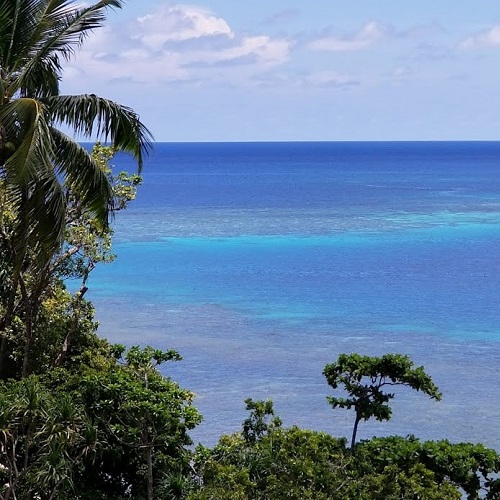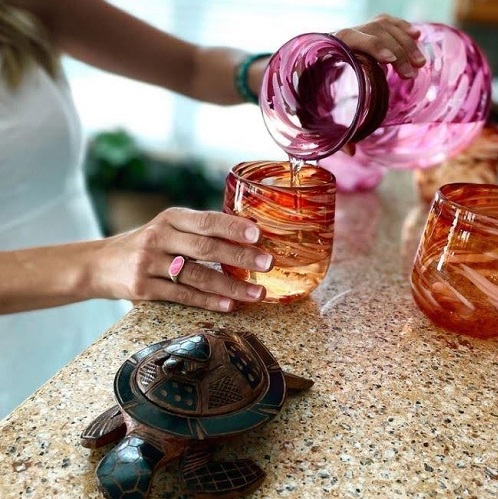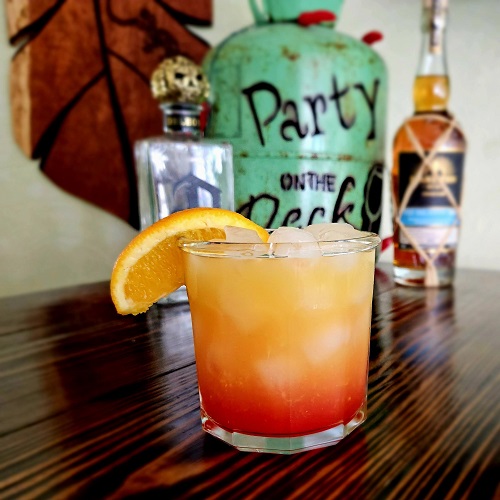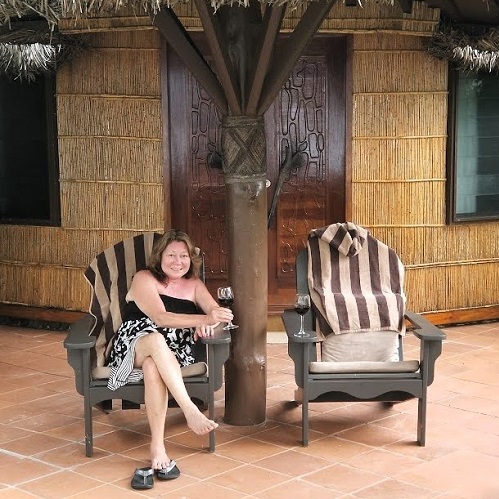
Tiki: A Uniquely Exotic And Vibrant Part of Americana

Tiki Culture: Is It Exploitation?
Tiki Décor Guide: How to Create an Awesome Tiki Space
This post contains affiliate links. A click and/or purchase through one of these links may result in a commission paid to us at absolutely no cost to you. Please be sure to read our Affiliate & Advertising Disclosure.
The origins of Tiki culture are rooted in Polynesian art and mythology with influences from surrounding Pacific islands. What we as Americans know as Tiki is a blend of several elements of these island cultures which is mixed with Americanized versions of
In our previous post, we explored the history of Tiki and defined what it actually is. Now we will dive into the various decorative and design elements of tiki, exploring everything from materials and textures, to colors, lighting, and artwork.
We will examine the variations in looks and styles (traditional, headhunter, pirate, and surfer) and how to decorate with it. After reading this post, you will be equipped with the knowledge needed to create your own wonderful, personalized tiki paradise!

Photo Credit: sfgate.com
In the world of Tiki, some people might come across things that they might have an issue with which they see as being inappropriate. We were going to briefly address the issue of cultural appropriation here but then found that in order to give that topic the attention it deserves, it should have its own blog post. The topic of cultural appropriation versus cultural appreciation is an important one so our separate post about it is available for those who are interested in learning more about it.
Having said that, what does tiki look like?
Tiki itself is immediately recognizable thanks to their unique blend of exotic, colorful, artistic, and whimsical elements. The visual language of Tiki includes a mixture of materials, motifs, colors, and patterns inspired by the natural world, island life, and Polynesian mythology.
Primary Elements of Tiki Aesthetics
Tiki Statues, Masks, and Warrior Clubs
The most iconic symbol of Tiki culture is the carved wooden or stone Tiki figure. These statues often have exaggerated facial features such as wide eyes, prominent mouths, and strong noses. They are based on carvings and representation styles that have been used by local islanders for centuries. Tikis can range in size from small figurines to towering monuments. Wooden masks and warrior clubs also feature very prominently in Pacific island cultures. Authentic, handmade pieces are created by local artists and are available in all sizes and designs. Some are more basic in appearance and others are very detailed and decorated. Wooden paddles and spears are also excellent additions.

Photo Credit: Tiki With Ray
Natural Materials
Tiki style embraces several organic materials. Notice the 2 types of wallcoverings in the photo above. These are foundational elements and are used in many forms including furniture, wall and ceiling coverings, and in roofing. They primarily come from bamboo, wicker, rattan, thatch made from palm leaves, and carved woods and stone. All of these used together create a real
- Bamboo: This lightweight yet versatile material is used for furniture, flooring, and decorative elements. Look for bamboo bar stools, tables, and light fixtures. Use bamboo wall coverings and large bamboo poles for framing walls and roof structures.
- Natural Woven Mats: Mats woven from various leaves and grasses work very well on walls and on floors to bring in the feel of the tropics. Seagrass or bamboo matting can be used to cover floors and outdoor areas. You can use it to cover patios, decks, and even driveway spaces. Mats used in this way can really transform a space!
- Tapa Cloth: This is a must if you really want some authenticity from the South Pacific. Tapa cloth has been made using centuries-old techniques. It is made by hand from the inner bark of the mulberry tree. The bark is beaten down to a thick paper-like texture and is then hand-painted in tribal and other local patterns using natural dyes and inks which are made from natural materials. Tapa cloth is available in large sheets and can be used as wallcoverings. It is also available in smaller pieces which make beautiful framed wall art.
- Wicker and Rattan: These materials add texture and visual interest. Large, rounded wicker-back chairs, rattan chairs, and coffee tables made from rattan and reclaimed wood all help to create intimate conversation areas within tiki spaces.
- Coconuts: Décor pieces and accents made from coconut husks and coconut shells add an authentic
tropical feel to tiki spaces.

Photo Credit: Tiki With Ray

Photo Credit: Retrorenovation.com

Photo Credit: Pinterest
Bold Color Palettes and Patterns
Tiki aesthetics feature strong uses of colors and patterns. The color palettes are bold and lively. Pale colors such as pastels are typically not used. Key colors include:
- Blues, especially turquoise, aqua and cerulean
- Coral, salmon, and pinks
- Medium to deep greens
- Bold yellows, oranges, reds and purples
- Lots of
tropical patterns including bold palm leaves, hibiscus flowers, and exotic birds such as toucans, parrots, and flamingoes. These are used in fabrics, wallpapers, artwork, and décor.

Photo Credit: midcenturymoderngal.com
Ocean and Nautical Motifs
Since Tiki is heavily influenced by Pacific Island cultures and their natural surroundings, ocean motifs like waves, fish, and seashells are often used as design elements. This also includes the use of nautical and sea-faring items as décor as they bring in the essence of life on the open water.
This category of décor includes the heavy use of glass objects like netted fishing floats in different colors, antique diving helmets, and even porthole windows which can have lighting installed behind them. It also includes lots of glass liquor bottles, both full and empty.

Photo Credit: Etsy
Tropical Trees and Plants
Palm trees, exotic flowers, and

Photo Credit: Amazon
Lighting
Lighting plays a critical role in Tiki design as it creates the magical, cozy.
Tiki involves the use of many lighting sources including dim, warm lighting from lanterns, Tiki torches, string lights, uplights, backlights, and other strategically placed lighting that helps to create a cozy, nighttime,
- String Lights: Hang lots of string lights or fairy lights around your tiki bar or patio to create a magical atmosphere. Choose warm white or colorful bulbs to complement your tiki theme.
- Uplights: These are small lamps fixed to a base which can be placed either in front of or behind tall plants, trees, statues, and sculptures. Placing them in front of these things accentuates them by lighting them up while placing them in behind these things creates a wonderful background glow while accentuating their shapes with silhouettes.

Photo Credit: Tiki With Ray
- Lanterns: There are many kinds of lanterns from glass and metal ones to paper or bamboo ones. These all add area lighting with a soft glow. These can be hung from the ceiling or placed on tables for added ambiance.
- Tiki Torches: Perfect for outdoor spaces, tiki torches bring the tropics to life. They create a festive atmosphere and not only provide light but they also evoke the sense of island living. Tiki torches with flameless candles or electric lighting are great for bringing the outdoor
tropical look inside too.

Photo Credit: sonomarepurpose.com
Cocktail Glassware and Barware
Tiki culture is all about entertaining and that includes awesome colorful cocktails. It also comes with the need for the right glassware as it is all about the aesthetic. Colorful, sculpted mugs resembling Tiki gods or
Essential Barware
- Tiki Mugs: Be sure to pull together a really cool variety of tiki mugs in different shapes and sizes. These mugs are iconic and create the tiki experience of enjoying
tropical cocktails.

Photo Credit: Myriahs.com
- Cocktail Equipment: Stock your bar with quality cocktail shakers, jiggers, and strainers. Consider a vintage or themed shaker to complement your decor. Also, make sure you have a very good quality, heavy duty blender.
- Glassware: Cocktail glasses in clear glass with awesome shapes such as hurricane glasses are a must so you can really show off creative and elaborate cocktails. Tall straight glasses are perfect for drinks such as mojitos while shorter ones are perfect for mai tais.

Photo Credit: webrestaurantstore.com
Cocktail Essentials
- A Wide Range of Top Shelf Spirits: Have a great selection of rums, tequilas and vodkas available. Other must haves fruit juices, coconut creams, a few great liqueurs, and flavored syrups.
- Garnishes: Keep a variety of fresh garnishes on hand, such as fresh fruit, mint, and edible flowers. Orchid blooms are awesome garnishes. All of these enhance the visual appeal of
tropical drinks. - Cocktail Recipe Books and Videos: Learn how to create classic tiki cocktails like the Mai Tai, Zombie, and Pina Colada. There are many excellent books and videos available by professional bartenders which can show you how to create the perfect drinks. These can also inspire creativity for you to branch out and create your own tasty versions! You can also create your very own custom cocktail menu to have on hand when entertaining friends and family.
Comfortable Seating
Tiki is all about comfort and relaxation. So when selecting furniture, comfort and aesthetics are key. If you are creating a home tiki bar, create cozy seating areas in addition to having actual bar stools at the bars. Include cushions with bold,

Photo Credit: Peerspace
Discover Tropical Home Décor Treasures
Bring island vibes into your home with exclusive artisan-made goods.
Designing Your Tiki Space
Creating a cohesive tiki environment either indoors or outdoors (or both!) involves thoughtful planning and attention to detail. Follow these steps to create your own, personal,
Step 1: Assess Your Space
Before you start moving existing things around and ordering anything online, take a close look at your space. How much space do you have to work with? What do you already own that you can use in your new tiki design? Take some time to carefully assess your space so mistakes are not made and so you don’t end up buying things that won’t end up working or that you simply don’t need.
Whether it’s a small corner of your living room or a spacious outdoor patio, understanding your area will guide your design choices. The space should allow for creativity and for comfort.
- Indoor Spaces: A sunroom, basement, living room, or spare bedroom can all be transformed into the perfect tiki space with the right decor and furnishings. Consider how much natural light the space receives. If you want natural light during the day, bright and airy spaces are ideal for creating tiki spaces as they can mimic the sunny days of island living. At night, they can become awesome, festive,
tropical escapes. - Outdoor Spaces: Patios, decks, and backyards are ideal for creating tiki spaces, especially with the addition of outdoor furniture, fire pits, tiki torches,
tropical plants, and the right outdoor decor. Outdoor furniture should be as comfortable as possible and made from weather-resistant materials. Look for pieces that have brightly colored upholstery and add in sometropical accent pillows. Consider the use of lounge chairs and even a hammock if space allows. Use strategically placed outdoor lighting such as string lights, lanterns, and tiki torches that will transform your space when the sun goes down so you can have that magical tiki atmosphere after dark.
- Size: Determine who will be using the space and plan for furniture accordingly. Measure the area to determine what furniture and decor will fit comfortably without overcrowding.
Step 2: Establish Focal Points
Every tiki space benefits from at least one focal point which draws the eye to the primary reason for the space. What is your reason for creating a tiki space? What should be the one big thing that captures the attention of those hanging out in it? Or maybe you have more than one.
If you have a larger space to work with and plan to create more than one defined area, each with its own purpose (a bar, a separate seating area, a pool table, etc), each of those can have their own focal point. Just create each area so if it had to, it could stand on its own completely separately from others. This way you create individual spaces within the same room, each for its own purpose and with a bit of its own personality. This creates definition. Then with everything actually being located in the same room, it becomes a wonderfully multi-purpose space with each area contributing individually to the overall look.

Photo Credit: Richard Barnes, Theming Tiki Bars
The focal points as seen in this example are as follows:
- A Tiki Bar: If you are creating a tiki bar, that can serve as the main attraction. Create backlighting in shelf spaces and niche lighting to highlight specific pieces of décor.
- Seating Areas: If your space will be a comfortable seating area, consider having a particular piece of wall art such as a vintage print, a large tiki mask, or a really cool wall-mounted sculpture which creates visual interest. Add a small fountain or water feature for an added
tropical effect. - A Pool Table: If your space is for playing pool or something similar, use design elements which will complement that while providing sufficient
tropical lighting and comfortable seating for those enjoying the game.
Step 3: Plan Your Layout
Pay close attention to creating the best possible arrangement of furnishings and décor pieces so you can achieve the best traffic flow patterns to maximize functionality of the space.
- Seating Arrangement: Create cozy seating areas that encourage conversation. Ensure there is enough space for people to move around comfortably.
- Bar Setup: If you are going to have a tiki bar, position it in the best way possible which allows for easy access to drinks and snacks. Consider adding bar stools and a high-top bistro table or two with chairs for guests.
- Bar Height: If you are going to buy a bar or have one installed, you simply need to measure the space for it and make sure your new piece will fit. However, if you are going to build your own bar, be very careful with your measurements. It has to be the right height for sitting, for standing, and for use by guests, some of whom will be taller and others who will be shorter.
- Bar Decor: Display colorful and unique barware, tiki mugs, cocktail shakers, and colorful
tropical décor pieces. Include a fully stocked liquor display which includes bottles of rum bottles and other spirits prominently. You can install shelving or use a sturdy bookcase which is finished in a way that blends into your tiki style.
Step 4: Choose Your Color Scheme
Once you’ve assessed your space and planned your layout, it’s time to establish a color scheme. Setting the mood with the right use of color is critical in tiki styles. You can use one or more color palettes if you have more than one focal point area too such as we discussed above.
- Accent Colors: Decide on a few key accent colors to complement your main palette. These can be used on the walls, on the ceiling, in your flooring, in textiles and upholstery, in artwork, and in decorative accents.
- Consistency: While tiki styles involves a heavy mix of different pieces and accents, nothing clashes or looks out of place when it all comes together. That’s the goal. So when painted surfaces will be visible, aim for a cohesive look which has your color choices working in harmony.
Step 5: Layer Textures. Tiki Needs Lots And Lots Of Layers
In tiki design, adding depth and interest is created by layering. Different textures are combined with different décor pieces in multiple layers to create a visually rich environment which is the goal.
- Mix Materials: Combine natural materials like wood, rattan, and bamboo in different forms such as in chairs, tables, accent pieces and in artwork.
- Textile Variations: Use different fabrics and natural fibers in upholstery, cushions, curtains, and in wall coverings for added textures and visual interest. These can be in a variety colors, patterns, and different styles of woven leaves and grasses.

Photo Credit: Richard Barnes, Theming Tiki Bars
Step 6: Incorporate Lighting
Lighting is the key element that creates the true tiki look. It sets the ambiance. What you want is the inviting glow of soft warm lighting in different forms to be accompanied by other lighting which provides other background colors. You cannot go wrong when incorporating multiple sources of subtle niche lighting along with decorative lighting from the ceiling, walls, from around the bar, and from intimate seating areas.
- Soft Lighting: Use several small lamps and lanterns to create a warm, inviting glow. Create different scenes in separate niches. Each of these can have its own subtle lighting.
- Layered Lighting: Layers of string lighting including fairy lights and bistro lights can be mixed in with colored Christmas lights. These can be mixed in with faux vines and plants that are fastened to ceiling spaces and which cover walls.
- Statement Lighting: Larger, pendant lights with warm or colored bulbs and shades made from bamboo and other natural fibers can be used in specific spaces such as entryways, seating areas, and randomly throughout the space. Large paper lanterns can be mixed in with these as well.

Photo Credit: Richard Barnes, Theming Tiki Bars

Photo Credit: Pinterest
Step 7: Add Your Own Personal Touches
Personalizing your tiki space is important because it is your space. They can take a lot of time and effort to create, depending on how elaborate you want it to be. While it needs to be inviting and special to all who enjoy it, be sure to make it your own space too. Here are a couple of ideas:
- DIY Projects: If you have an artistic side and you like DIY projects, creating a Tiki space offers an endless array of opportunities. You can be as creative as you want to be. Check out what some people can do with things like foam and other materials. This is the Fugu Lounge on Facebook and the owner is a true artist. These spaces look like they could easily be in a theme park! So consider what you like to do and craft what you can on your own from tiki carvings to your own
tropical -themed artwork. - Travel Souvenirs: Include items from your own travels which can add to your tiki look. Your personal mementos will give your tiki space its own authenticity.
Tips For Building Your Own Tiki Bar
Unless you have built a few of your own furnishings in the past and are familiar with proportion and scale, it is very easy to have pieces come out larger or smaller than expected. This doesn’t mean you measured your space incorrectly. It means understanding proportion and scale so you can figure out the right measurements of the piece you envision so it is the right size for the space. You want your finished piece fit into your available space without it looking too big or too small.
As an example, I happen to be tall, 6’5” to be exact. Very few things are built for people who are my height and taller. I could build a bar which would be comfortable for me to use but that doesn’t mean it will look right when placed in a room along with other furnishings. It’s a bit like having the countertops in a kitchen or bath replaced during a remodel or comfortable for others to use. Countertops for my height would be awesome (the standard builder height is too low for me) but they will obviously look like they were installed for a tall person. For shorter people, they would not be practical. It’s the same when it comes to tiki bars or any other kind of bar for that matter. These are typically focal points in a room which means they will be the first thing people notice. You want them to fit into your space in the best possible way so that they look awesome, both in appearance and in scale, and are as comfortable as possible for you and your guests.
So here is what happened to us: Our middle son is quite tall too, he is 6’3”. He loves to work with wood and insisted that we needed a bar. We had been fine without one up to this point, nearly 30 years without one. But he insisted. So we said OK, off you go, build us something nice. He took his measurements and turned our garage into a woodworking shop for this project. I reminded him to be careful and to double-check his measurements as he progressed because our living room is not that big. He assured us all was well, continued on, and built this beautiful bar for us.

Photo Credit: Cerulean Bay
Prior to staining it, we brought it in to see how it would fit and things were off just a bit. It is officially the largest piece of furniture in the room. Edna is only 5 feet tall and allowed this picture of her to be used for scale and perspective. I teased her and said, “Today we are having small drinks”. It was very funny, you had to be there.

Photo Credit: Cerulean Bay
It was definitely taller and wider than we were expecting. He felt bad and wanted to see if he could tweak it to make it smaller but we loved it and were determined to make it work. After all of his hard work, he finished it up for us. He is truly awesome and we absolutely love him and our new bar! While it is not technically a tiki bar, it has the

Photo Credit: Cerulean Bay
It has a lot of storage for bottles and supplies, and even has room for our bar fridge and all of its beer.

Photo Credit: Cerulean Bay
(A professional tip: Darker colors shrink pieces just as they shrink rooms when painted on walls. That helped to visually “shrink” the bar for us). First he used a propane torch to lightly burn the wood grain and knots to darken and highlight them. Then use chose two very dark stains for the planks and the trim. Finally, he finished the top with a heavy duty clear gloss varnish that is typically used on boats. We had a

Photo Credit: Cerulean Bay
Here is another angle for bar height reference.

Photo Credit: Cerulean Bay
So there are your tips and warnings when it comes to building pieces for yourself. If our bar ended up being any bigger, we would have been in trouble because it simply would have been too big.
Final Thoughts on Tiki Home Décor
Understanding the elements of tiki and how to use them will allow you to create a personal space which will transport you to a magical










